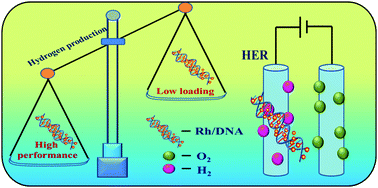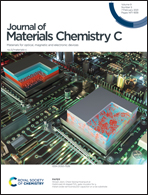Shape-selective rhodium nano-huddles on DNA for high efficiency hydrogen evolution reaction in acidic medium†
Abstract
Hydrogen gas (H2) production from electrocatalytic water splitting is one of the main alternative green energy sources to overcome the fossil-based energy demands in future. For large-scale H2 production, properties such as low overpotential, stability, sustainability and resistivity are the major things to address in the designing of an electrocatalyst. In this line, we have constructed a shape-selective ultra-low Rhodium (Rh) nanoparticles (NPs) as an active electrocatalyst for the hydrogen evolution reaction (HER). However, the high cost and scarcity of Rh are barriers to its utilization in large scale electrocatalytic water splitting. The idea of using biomolecule DNA to reduce the Rh metal percentage and also erradicate the use of external binder is an alternate strategy in the field of electrocatalysis. Also, the method of DNA metallization (Rh/DNA) is quite simple to prepare within a short time span of just 15 min in aqueous medium. The resulting DNA mediated Rh nano-huddles (Rh/DNA-1) shows excellent activity in the HER of 0.5 M H2SO4 with a mass loading of 0.007 mg cm−2, which is comparatively 30 times less loading than the commercial loading of 0.205 mg cm−2. Because of this low loading, the observed mass activities were really huge and Rh/DNA-1 showed 1257 A g−1 at an overpotential of 100 mV. Rh/DNA-1 required an overpotential of 105 mV to reach the current density of 10 mA cm−2 and 194 mV for 50 mA cm−2, respectively. Also, it showed excellent stability over 36 000 s at a current density of 10 mA cm−2 in chronoamperometry studies with no loss in activity. Moreover, the catalyst shows a very low charge transfer resistance (Rct) of 1.8 Ω and follows facile kinetics with a lower Tafel value of 68 mV dec−1 for Rh/DNA-1. Further, the TOF was calculated at 300 mV and Rh/DNA-1 showed 0.00064 s−1. For comparison, Rh NPs without DNA were studied for the HER and required 97 mV at 10 mA cm−2 with 0.205 mg cm−2 loading, showing the essentiality of DNA in the electrocatalytic HER study. Therefore, DNA-based electrocatalysts may help to develop cost effective and efficient electrocatalysts in the near future.



 Please wait while we load your content...
Please wait while we load your content...